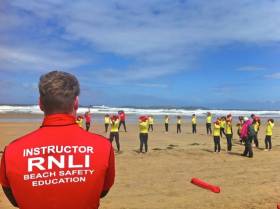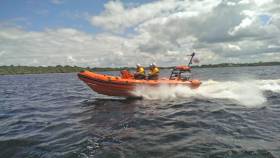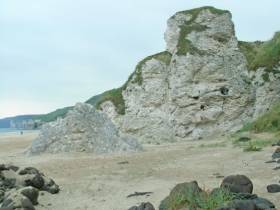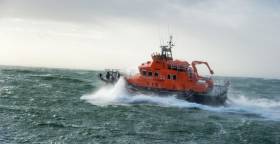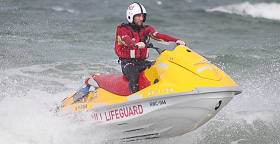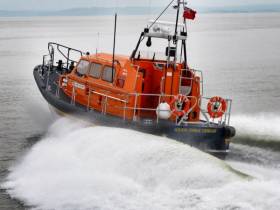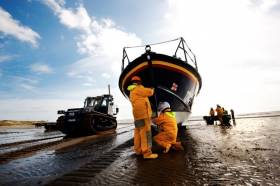Displaying items by tag: RNLI
#Lifeguards - RNLI lifeguards are hitting the surf again and bringing their popular beach safety programmes to school children and youth groups in Northern Ireland.
Hundreds of children have already been through the programmes and learned valuable and important advice to keep safe in the water and along the shore, in a fun and interactive way.
Last summer 345,027 people visited the 10 RNLI-lifeguarded beaches on the Causeway Coast and in Co Down. Of these people 27,043 entered the water while 9,975 took part in surfing or other water leisure actives such as body boarding and kite surfing.
The lifeguards responded to 182 incidents, coming to the aid of 218 people. As well as rescues carried out in the water, lifeguards also dealt with falls, first aid and lost children.
The RNLI lifeguarding season has already begun on five beaches along the Causeway Coast and this cover will be extended for the peak summer season from Saturday 25 June through to Sunday 4 September.
In the run up to this and before schools break up for the summer, the RNLI is encouraging primary schools and youth groups to sign-up for its two beach safety education programmes.
The ‘Meet the Lifeguards’ and ‘Hit the Surf’ programmes teach young people the importance of beach safety in a fun and practical way.’
‘Meet the Lifeguards’ is an interactive session where RNLI lifeguards visit a school or youth group and teach the children key safety advice that they then put to use when they visit a beach with family and friends.
Children learn what the different beach safety flags and signs mean, the safety of using inflatables, the dangers of 'tombstoning', sun safety and how to identify natural and man-made hazards in and around the water. They will also learn about body boarding and surfing safety and how to escape a rip current. Information on tides and waves is included in the session.
The ‘Hit the Surf’ programme, meanwhile, offers a unique opportunity for school children or youth groups to get practical lessons in lifesaving and beach safety at one of the 10 RNLI-lifeguarded beaches located on the North Coast and in Co Down, or inland for the first time on the shores of Lough Erne in Cp Fermanagh.
The two-and-a-half-hour session includes a lesson on staying safe at the beach and explains the role of the RNLI and its lifeguards. It is followed by a lifesaving lesson and learning surf-based skills while building the children’s confidence in the sea. They will also learn about local hazards and the beach environment.
For more information on how to book your school onto an RNLI education programme in Northern Ireland, contact RNLI lifeguard supervisor Jenny Thompson 077 8992 4563 or email [email protected]
Bundoran RNLI Lifeboat Called to Donegal Town
The volunteer crew of Bundoran RNLI were last night requested to launch by Malin Head Coast Guard to reports of a person in the water at the pier in Donegal Town.
Following a 999 call from some passers by, the lifeboat was paged just after 11.45pm and launched around 11:53pm, proceeding to Donegal Town. On arrival on scene at 12:15am the crew commenced a search of the pier area in coordination with the Sligo based Rescue 118 Helicopte, the Killybegs Coast Guard boat, Gardai, Fire Service and HSE Ambulance.
Shortly after 1am, a person was recovered from the water and handed over to the waiting ambulance crew on the pier but was sadly later pronounced dead.
The management and crew of Bundoran RNLI Lifeboat extend sympathies to familiy and friends of the deceased.
Two Callouts In 24 Hours For Lough Ree Lifeboat
#RNLI - The volunteer lifeboat crew with Lough Ree RNLI were called out twice in 24 hours to assist grounded vessels in the Wood Shoal area.
Thankfully there were no injuries any of those on board across both vessels, but the RNLI has advised marine users in the area to use caution and heed advice around submerged rocks.
The first callout came after midday on Tuesday (29 March) to reports of a cruiser with 10 people onboard grounded at Mouse Ear Rock.
When on scene, a lifeboat crew member boarded the vessel and assessed it for damage. There was a strong vibration from the engine and it was suspected that there may be damage to the propeller.
The lifeboat crew took the vessel under tow to Portrunney were it could be checked over for damage. The lifeboat was back on service shortly after 2pm with everyone safely ashore.
The second callout came the next day (Wednesday 30 March) at 3.35pm and was again to a grounded vessel, this time at Iskeraulin Shoal, south of Quaker. There were six people onboard with no reports of injuries.
On arriving on scene at 4.06pm, the lifeboat crew again assessed if there was any damage to the cruiser.
When it was confirmed that everything was working they helped the vessel free of the rocks and monitored its progress by travelling alongside it for a time. Once satisfied there was no further difficultym they departed the scene and returned to the station.
Commenting on the callouts, Lough Ree RNLI lifeboat operations manager Damien Delaney said: "Our volunteer lifeboat crew had a busy 24 hours. We would urge everyone using Lough Ree to ensure they are familiar with the area and to take heed of any warnings for rocks.
"Grounded vessels are not unusual but with any callout there are a number of factors that should be considered, such as weather and the right equipment. Make sure you have a suitable means of calling for help and that you have the proper clothing and a lifejacket. You never know when you will need to call for help."
Lough Ree was among the busiest of Ireland's lifeboat stations in 2015, recording the highest number of people assisted, as previously reported on Afloat.ie.
Portrush Lifeguard Aids Man Injured In Whiterocks Cliff Fall
#CliffFall - An RNLI beach lifeguard aided a man who fell onto rocks while walking a steep cliff path on Whiterocks beach in Portrush yesterday afternoon (Wednesday 30 March).
The call for help came after a member of the group the man was with observed him fall just before 1pm and raised the alarm.
After arriving on scene, senior RNLI lifeguard Jamie Russell immediately began to administer casualty care to the conscious man, who had fallen some 12 feet from the coastal path. He was joined on scene by a paramedic and they continued to provide assistance.
However with an incoming tide and a challenging location, it was decided that removing the casualty would require the assistance of Coleraine coastguard.
The man was secured on a stretcher and carefully moved by the group around the rocks to a waiting ambulance.
Commenting on the callout, RNLI lifeguard supervisor Karl O’Neill said: "This incident was quite a challenging one to respond to due to the nature and location of the fall.
"Thankfully the man was conscious but we did not want to risk any further discomfort or injury by moving him ourselves. I would like to thank members of Coleraine coastguard for their assistance."
Whiterocks is one of five beaches being patrolled by RNLI lifeguard during the Easter holidays, continuing till Monday 4 April, as previously reported on Afloat.ie.
Bangor Lifeboat Aids Fishermen After Engine Failure
#RNLI - Bangor RNLI’s volunteer lifeboat crew were requested by Belfast Coastguard to help two fishermen on a 17ft motorboat with engine failure.
Although conditions were calm and the crew were in no immediate danger, the westerly wind was extremely cold and blowing the fishing boat offshore.
The call to lifeboat operations manager Kevin Byers came in at 5.06pm yesterday evening (29 March) and the lifeboat launched at 5.15pm.
The lifeboat made its way to the reported position to the south of the Gobbins outside Belfast Lough, only to find the boat wasn’t there, and they were only able to locate it by radioing the boat for a position update.
On arrival, the volunteer lifeboat crew made sure the boat and crew were sound, and towed the boat to Carrickfergus Harbour, where they were thanked by an extremely grateful skipper.
Helming Tabby Cat, the temporary replacement for Bangor's regular lifeboat Jessie Hillyard, Bangor RNLI crewmember Gareth Whan said: “An incident like this emphasises the importance of good engine maintenance, particularly as many boats have been unused over the winter months.
“It also demonstrates the importance of warm clothing, as the crew of the rescued boat were extremely cold by the time we reached them – it is always much cooler on the water than it is on dry land.”
#RNLI - Rosslare Harbour RNLI's volunteer crew launched their all-weather lifeboat at 2am this morning (Wednesday 30 March) on request by the Irish Coast Guard to attend an injured man who was working on the Tuskar Rock lighthouse.
Once on scene, 8km from Rosslare Harbour, the all-weather lifeboat deployed its Y-class rescue boat to reach the landing area on the rock, but due to a heavy swell a landing was not possible.
Lifeboat operations manager David Maloney had anticipated that scenario and had already requested the coastguard helicopter Rescue 117 from Waterford.
The helicopter was quickly on scene and lifted the injured man aboard, flying him to Waterford Airport where an ambulance was waiting to transfer him to hospital.
Apart from a heavy swell, weather conditions at the time were calm with a clear dry night. The lifeboat remained in the area until the airlift was completed and then returned to base at Rosslare Europort.
Commenting after the event, Maloney said: "The lifeboat crew were quite correct in not attempting to land on the rock due to a heavy Atlantic swell. We wish the man a full recovery."
RNLI Takes Part in Easter 1916 Centenary Commemoration
RNLI volunteer lifeboat crew from across Ireland took part in today’s Easter 1916 centenary commemoration which saw over seven hundred members of the Irish emergency services taking part in the biggest parade in the history of the state. The fifty RNLI volunteers came from twenty-nine lifeboat stations around the Irish coast and inland to parade through Dublin City Centre to mark the centenary of the Easter Rising in 1916. The RNLI formed part of the emergency services section of the parade which recognised the ‘blue-light’ agencies serving the Irish state since its foundation.
The RNLI contingent was accompanied by a new Atlantic 85 lifeboat, which following its debut in the parade, will be transported to Youghal in Cork to go on operational service, and two RNLI landrovers used in the launching of inshore lifeboats.
The parade was preceded by a short ceremony which included a reading of the 1916 Proclamation and the President of Ireland Michael D Higgins laying a wreath on behalf of the people of Ireland, followed by a minute’s silence observed for all those who died during the Rising.
The parade involved over 3,000 participants, largely from the Irish Defence Forces with 793 people from the emergency services. Represented along with the RNLI were An Garda Siochána, Dublin Fire Brigade, the National Ambulance Service, St John Ambulance, Irish Coast Guard and the Civil Defence.
Commenting on the commemoration RNLI Operations Manager Owen Medland said, ‘It is a huge honour for the RNLI to take part in this historic event. It is an acknowledgement of the role our volunteers have played in saving lives at sea and on inland waters in Ireland since the RNLI was established in Ireland in 1826. The lifeboat service has been given without any interruption historically and has always put the needs of those in danger on the water above all.
Our volunteers come from all communities and backgrounds and the RNLI is proud of the role Irish volunteers have played in saving countless lives and continue to play today and into the future.’
Many of the volunteers taking part had relatives who were involved in the events of 1916 and the following years. Clifden RNLI volunteer lifeboat Coxswain Alan Pryce is the grand-nephew of Thomas Whelan of Clifden Co. Galway, one of the ‘Forgotten Ten’, who was executed in Mountjoy Prison during the War of Independence in 1921.
Clogherhead RNLI Volunteer Shore Crew member Carolyn Stanley is the grand-niece of Joe Stanley who was Pádraig Pearse’s press agent and printer. During the Easter Rising Pádraig Pearse relied on his young press agent, Joe Stanley, to convert his hand written communiques into printed documents for onward circulation throughout the city. It was Joe Stanley who published the First Documents of the newly proclaimed republic.
Fethard on Sea RNLI volunteer Deputy Launching Authority and former lifeboat helm Hugh Burke is the nephew of John Fenlon. Following the 1916 rising in Enniscorty John was arrested and locked up in Wexford jail from where he escaped and remained on the run for seven years.
Lifeboat stations represented at the Easter 1916 parade were Achill, Wexford, Arklow, Lough Ree, Howth, Baltimore, Donaghadee, Dun Laoghaire, Dun Laoghaire, Kilmore Quay, Wicklow, Ballyglass, Clifden, Courtmacsherry, Clogherhead, Dunmore East, Bundoran, Helvick Head, Kinsale, Crosshaven, Portaferry, Youghal, Lough Swilly, Kilrush, Fethard, Red Bay, Union Hall, Skerries and Sligo.
RNLI lifeguards will patrol five beaches on the Causeway Coast during this year’s Easter holidays.
Starting on Good Friday, lifeguards will be operating from Beach Lifeguard Units on Benone Strand, Portstewart Strand, East and West Strands in Portrush and Whiterocks.
The lifeguards will be on duty from 11am to 7pm starting on Good Friday, 25 March and continuing daily to Monday 4 April.
Weekend cover on the Causeway Coast and Tyrella Beach in County Down will then commence on Saturday 30 April and continue up to the beginning of the peak Summer season when 10 beaches on the Causeway Coast and in County Down will commence daily cover from Monday 13 June through to Sunday 4 September.
The new season arrives following a period of intensive work for the lifeguard management team to train the lifeguards and prepare the seasonal equipment.
With Easter falling earlier than usual this year, Mike Grocott, RNLI Lifeguard Manager is reminding anyone planning a visit to the beach to remember that it is still cold and to go prepared.
‘Easter is early and the beaches and the water are still very cold. Please bear this in mind and come dressed for the weather conditions to ensure your visit is both safe and enjoyable.’
Mr Grocott said pre-season preparations had gone well and the lifeguards were now looking forward to putting their training to use:
‘Working alongside our colleagues in the Causeway Coast and Glens District Council, the RNLI is delighted to be back on five of our lifeguarded beaches for the Easter season. Our lifeguards have been busy in the last month undergoing intensive training to be ready for Easter. This year, for the first time, we welcomed our lifeguarding colleagues from Wales and the north of England to share their lifeguarding experiences and to train on our beaches on the north coast.
‘With the training complete, our lifeguards are looking forward to being back on patrol and to putting their skills into action. We would encourage visitors to the beach in the coming days to speak to our lifeguards, ask for safety advice, and most importantly call on them should they find themselves in difficulty’.
The RNLI’s advice for anyone planning a trip to the beach is to respect the water, check weather and tide times before you go and if planning to go into the water, swim at a lifeguarded beach, between the red and yellow flags. Avoid using inflatables in strong winds or rough seas.
If you get into trouble, stick your hand in the air and shout for help and if you see someone else in trouble, tell a lifeguard. If you can’t see a lifeguard, call 909 or 112 and ask for the Coastguard.
Last year, lifeguards in Northern Ireland responded to 182 incidents coming to the aid of 218 people. Incidents ranged from dealing with stings, slips and trips to major first aid incidents as well as rescues in the water.
One incident included a life saved, while there were eight cases during which 11 people were rescued and 36 instances which saw the lifeguards assist 68 people. Nine people were treated in major casualty care incidents including body boarders, paddle boarders and kite surfers while 95 people were assisted with minor first aid. The lifeguards were also involved in four searches last year.
Despite a wet summer figures show that 345,027 people visited the 10 beaches last year. Some 27,043 of those visitors took to the water while 9,975 were using surf or other craft.
There were a number of unusual incidents to deal with last year summer too, including responding to a sand dune fire, red flagging beaches in a severe thunder and lightning storm and dealing with the discovery of mortar bombs.
Lough Swilly RNLI Extend their Sympathies to the Bereaved Following the Tragedy at Buncrana Pier
The volunteer lifeboat crew and station management at Lough Swilly RNLI wish to extend their deepest sympathies to the families and loved ones of the five people who lost their lives following the events at Buncrana Pier on Sunday night (20 March 2016).
Commenting on the tragedy, John McCarter, Lough Swilly RNLI Lifeboat Operations Manager said: ‘Our volunteer lifeboat crew were one of the first emergency services on scene and recovered the five casualties from the water. We were devastated to learn subsequently that those five people, including young children, had lost their lives. We wish to commend the actions of the member of the public who selflessly entered the water and rescued the baby and we wish them both a full recovery.
John McArthur, Operations Manager with Lough Swilly RNLI, describes the rescue and recovery effort at Buncranahttps://t.co/0m8JutqMFc
— RTÉ News (@rtenews) March 21, 2016
‘While our volunteer lifeboat crew train for and respond to every possible incident, the events in our community last night, were extremely tragic and challenging for our lifeboat crew. I want to thank our volunteer lifeboat crew along with the other emergency services and members of the public who responded to this emergency for their professionalism and their courage. Our thoughts are now with the families who have lost loved ones in this awful tragedy.’
#RNLI - Clogherhead RNLI's volunteer lifeboat crew launched their all-weather lifeboat at 11:50am yesterday (Sunday 20 March) in response to a distress EPIRB signal received from a fishing vessel located 25 miles east of Clogherhead.
While en route to the location of the signal, the Clogherhead crew was informed that the Irish Coast Guard helicopter Rescue 116 had winched the three people from a liferaft and were proceeding to hospital.
The lifeboat continued on to the signal's location in good weather and calm seas, arriving at the scene at 1:38pm. The liferaft was located and recovered and the EPIRB was found nearby a short time later.


























